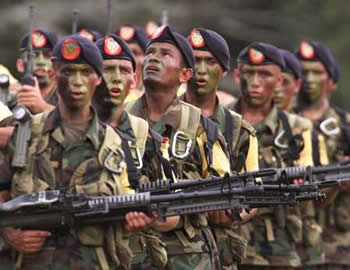Leftist parties did well in Colombia’s latest round of regional elections held in late-October 2011. These were the first polls since the election of President Juan Manuel Santos, who is on the centre-right of the Colombian political spectrum. The lead-up to the regional elections were marred by violence, but the results, in which a former leftist guerrilla won a regional seat, may indicate growing political success for the left in Colombian politics.
Retaining one of the largest militaries in South America, the country’s 40-year-old civil war, and actual and potential regional rivalries with its neighbouring states of Venezuela and Brazil, continues to dominate its security agenda. Neither the Marxist-orientated ELN (Ejército de Liberación Nacional/National Liberation Army) and FARC-EP (Fuerzas Armadas Revolucionarias de Colombia–Ejército del Pueblo/Revolutionary Armed Forces of Colombia-People’s Army) show any immediate sign of slowing, or halting, their armed campaign against the Colombian government. In fact, the ELN’s campaign appears to have intensified over the past 12 months, following the cessation of in-fighting with the FARC-EP.
The FARC-EP has suffered recent setbacks, including the killing of its commander in November 2011, although it remains capable of performing attacks on civilian and military targets. The government continues to follow a dual track of political negotiations with the FARC-EP, and military action against the group. Inextricably connected with the military campaign against these respective insurgencies is Colombia’s procurement of military equipment. The domestic defence industrial base in Colombia is modest at best. The result of this has been that Bogotá has had to search abroad for defence materiel. Traditionally, Colombia has made significant purchases of defence equipment from the US, particularly of armoured vehicles and aircraft. That said, the country is now in the process of broadening its supplier base. This has included the purchase of ground attack aircraft from Brazil, and warships from Germany. The country’s military relationship with Israel is also deepening in the form of the supply of aircraft upgrades, tankers and advanced cruise missiles.
Ostensibly, these purchases have been to enhance the Colombian military’s capabilities vis-à-vis the continuing insurgency. However, a side effect of the purchases of this equipment particularly these latter three platforms, are that it provides the country with modest power projection capabilities beyond its borders. This could be a cause for concern in the future, particularly as regards the, at times tense, relationship between Brazil, Venezuela and Colombia. All three of these countries are recapitalising their defence equipment, which is being done in part to address obsolescence issues in existing inventories.
Nonetheless, some commentators have noted that such purchases seem to give the appearance of a regional arms race. That being said, despite the occasional sabre-rattling between the three powers of Colombia, Brazil and Venezuela, it is almost certain that neither country is keen to embark on a regional conflict that could be incalculably costly in terms of blood and money.










